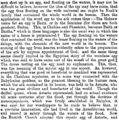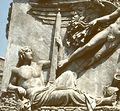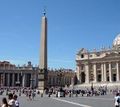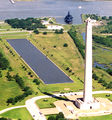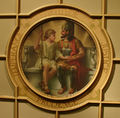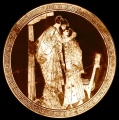911:Occult symbolism XII
Site menu:
- Occult symbolism Intro
- History of oppression
- Social terrorism
- Economic terrorism
- Occult symbolism pages:
- Introduction to symbolism
- Part I (Egyptian mythology, Pyramid, All-seeing eye, Obelisk)
- Part II (Astrology)
- Part III (Stars)
- Part IV (Cross, Rods, Awen, Thunderbolt, Bell, Shell)
- Part V (Occultism)
- Part VI (Circles, Infinity, Spirals)
- Part VII (Deities)
- Part VIII (Colors)
- Part IX (Alphabets)
- Part X (Animals, Insects, Arachnids)
- Part XI (Plants)
- Part XII (Life, Death, Sexuality)
- Part XIII (Alchemy)
- Part XIV (Masonic symbolism)
- Part XV (Masonic places)
- Part XVI (Hand signs)
- Part XVII (Occult Media Programming)
Life
Egg
Linked with the central mystery were countless lesser mysteries, the hidden meaning of which was known only to the initiates, but the outward forms were practiced by all the people. Among these were the doctrines of purgatorial purification after death, salvation by countless sacraments (such as priestly absolution), sprinkling with holy water, the offering of round cakes to the queen of heaven (as mentioned in the book of Jeremiah), dedication of virgins to the gods (which was literally sanctified prostitution), weeping for Tammuz for a period of 40 days prior to the great festival of Istar (who was said to have received her son back from the dead); for it was taught that Tammuz was slain by a wild boar and afterwards brought back to life. To him the egg was sacred, as depicting the mystery of his resurrection even as the evergreen was his chosen symbol and was set up in honor of his birth at the winter solstice, when a boar's head was eaten in memory of his conflict and a yule log burned with many mysterious observances. [36]
- The egg is used as a symbol of ressurection
- Also see:
The pagan festival of Astarte or Ishtar (Easter) is always held in late april to celebrate the earth regenerating itself after winter. Eggs and rabbit (Note: Rabbit symbol for Playboy Magazine) symbols were used for fertility
- Vatican Egg symbolism
- Commercial usage of the egg symbol
Easter egg tradition using the rabbit symbol.
Kinder egg
Cosmic egg
- See also: pine cones, Cosmology
- Eggs (Easter). Eggs were symbolical from an early time. There was the "Mundane Egg", in which Brahma gestated, with the Hindus the Hiranya-Gharba, and the Mundane Egg of the Egyptians, which proceeds from the mouth of the "unmade and eternal deity", Kneph, and which is the emblem of generative power. Then the Egg of Babylon, which hatched Ishtar, and was said to have fallen from heaven into the Euphrates. Therefore coloured eggs were used yearly during spring in almost every country, and in Egypt were exchanged as sacred symbols in the spring-time, which was, is, and ever will be, the emblem of birth or rebirth, cosmic and human, celestial and terrestrial. They were hung up in Egyptian temples and are so suspended to this day in Mahometan mosques. [37]
- The philosophical or cosmic egg is another nearly universal symbol. Alchemically, the egg is a symbol of the cosmos, as it is in a multitude of folk legends. In Hindu cosmology, it is the source of the universe. The egg as a container of the universe is found in many ancient religions. The egg symbolizes birth and potential. It contains within a miniature Phanèssun, and it features prominently in solar mythology. The gods Vishnu, Phanès (Orphism religion), and Mithras, are all “egg born” solar deities. Another solar entity, the rooster, is also born of an egg. [38]
- Eggs of Ostara
The birth of Mithras from the Cosmic Egg. As Soma is born from the Golden Embryo. [3]
Some archaeologists refer to this stone (egg shaped) as an omphalos stone, and compare it to similar stones found in Delphi. The omphalos stone identified a site as a “centre of the world”, as well as a meeting place of heaven and earth. [4]
Death
- Various notes:
- See also: Human skull symbolism
Skulls and bones
- Various notes:
- See also: X symbolism
- "The Jesuit Order would fly the Skull & Crossbones on their Black ships. These ships were shown in the program 'Shogan' with Richard Chamberlain from the eighties. Their known as the Brotherhood of Death. This is where the Knight of Malta controlled, Nazi SS got their name and then the Russell Trust, Yale society 'Skull & Bones'. Study certain Jesuit churches and their fascination with the skulls and bones. Study the I-Mori and their fascination with skulls." -Craig Oxley
- Various skulls and bones:
Skull And Crossbones At The Vatican [5]
The skull and crossbones, as seen in this photo at the Shrine of Saint Joseph in downtown Saint Louis, Missouri, is an obvious symbol for death
Note: the Butterfly.Logo of the Skull and Bones secret society at Yale University, of which Prescott Bush, George Bush Sr. and George Bush were/are members. Membership is for life.
- George Bush Sr S&B2.jpg
(see previous)
Deaths Head on front of Imperial German helmet
Picture showing Deaths Head on Germany's Kaiser Wilhelm II own Liebgarde Hussar regiment of Potsdam, Berlin.
Arnold Schwarzenegger on the June 25th 2007 cover of TIME magazine.
- Black Hand skulls and bones: The Constitution of the Unification or Death Society (IV. The Seal and the Oath of Allegiance, Article 34.)
- The Organisation's official seal is thus composed: In the centre of the seal there is a powerful arm holding in its hand an unfurled flag on which - as a coat of arms - there is a skull with crossed bones; by the side of the flag, a knife, a bomb and a phial of poison (The Jesuits Favorite assassination method, another of their trademark). Around, in a circle, there is the following inscription, reading from left to right: "Unification or death", and in the base: "The Supreme Central Directorate". [39]
Seal of Black Hand (Serbian: Црна рука / Crna Ruka), officially Unification or Death.
Note: Black Hand along Young Bosnia was a Mazzini enterprise which after the assassination of Franz Ferdinand Archduke of Austria, caused WWI linking the Jesuits direclty to WWI.
- Nazi Totenkopf:
The German secret service logo is the symbol of Jupiter, or Lucifer. Chief of the Nazi Sicherheitdienst Walter Shellenberg says this: The SS had been organized by Heinrich Himmler according to the principles of the Jesuit Order. The rules of service and spiritual exercises prescribed by Ignatius de Loyola constituted a model which Heinrich Himmler strove carefully to copy. Absolute obedience was the supreme rule; every order had to be executed without comment (As quoted in World War Two in the News: "Death of Heinrich Himmler." ). [6]
Nazi Totenkopf ring
The Deaths Head emblem used by the Nazi SS.
Ossuary
- Sedlec Ossuary
- Capuchin Church (Vienna)
- Chapel of Bones Pictures - Capela dos Ossos in Evora, Portugal
Also see: Catacombs, bone chapels.
Society of Jesus Logo made from human bones [7]
Schwarzenberg Coat Of Arms at Sedlec Ossuary [10]
Bone chandelier in the Sedlec Ossuary [11]
Sexuality
- Various notes:
Female
- Various notes:
- See also:
Virgin
- Parthenogenesis (divine birth, virgin birth)
 "The Cult of Divine Birth in Ancient Greece", Marguerite Rigoglioso, ISBN 978-0230614772
"The Cult of Divine Birth in Ancient Greece", Marguerite Rigoglioso, ISBN 978-0230614772
- audio: gnosticmedia interview
- Catholic Virgin Mary
Vagina
- See also:
- According to Dr. Anthony Perks' ("Stonehenge: A view from medcine" [40]) new theory that Stonehenge symbolically represents a vulva at childbirth when viewed from the sky; the Altar stone represents the clitoris. The U-shaped "Horseshoe" formed by the bluestone trilithons represents the labia minora and the outlines the vaginal opening of the symbolic Stonehenge birth canal. The outer circle of trilithons, and possibly the outer bank or mound, represents the labia majora. [41]
Yoni
- The ring (or hoop) is an ancient female symbol. Many people still refer to it by its ancient Sanskrit name, “yoni.”
- The word “yoni” can refer to the external female parts, i.e. the vulva, or to the entire female genital system including the vagina. Interestingly, in many ancient cultures including Roman society, prostitutes solicited passers-by by sitting in their windows and holding up their hands with thumb and index fingers coming together at the tips thus showing their trade symbol, the yoni.
- Many ancient statues and images show goddesses holding rings in their hands or with rings attached to various parts of their bodies. The rings were not always perfectly round, however. Sometimes, they were oval or even double-pointed ellipses. Why was this so? In the process of childbirth, the shape of a woman’s vulva will first stretch into a double-pointed ellipse. As the child’s head begins to crown, the edges will slightly round off forming an oval. Finally, as the child proceeds to full birth, the top and bottom of the vulva smooth out even more, forming a circle. Therefore, all of these shapes have come to symbolize the female procreative role.
- A yoni is also symbolic of a temple where the “divine essence” of a woman is worshipped. This is another reason why temple prostitution was considered sacred. The “Queen of Heaven” (Semiramis) was worshipped as men entered into her temple, i.e. as they had sexual intercourse with one of the temple prostitutes. [42]
Yoni (paleolithic Ferrassie), Shri-Yantra has superimposed yoni-lingam motifs,Yoni (South India) [12]
Placenta
- Various notes:
- See also:
(todo)
Breasts
todo: mammary-breast domed buildings
The top of the building which houses the Dead Sea Scrolls, is shaped as a female breast and has milky-white water squirting onto it 24 hours a day.
The Society of Jesus (Jesuits) was first constituted in the chapel of Notre Dame Church in Montmartre, Paris, 1534. Now this church is called the Sacre Coeur (Sacred Heart). [13]
The Großer Platz: Part of Hitler's "Germania" project, the building would have been over 200 metres high and 250 metres in diameter, sixteen times larger than the dome of St. Peter's.
Milk
todo: milk grotto Bethlehem
The white patches on the walls of the milk grotto in Bethlehem are supposedly preserved milk from the breasts of Mary that apparently squirted against the walls as she nursed the baby Jesus. [14]
Male
Phallus
- See also:
- List of fertility deities
- Min (god). This egyptian god Min was a fertility dark-skinned god depicted with an erected penis and a flail. Also know as Khem or Min, he was the god of reproduction; as Khnum, he was the creator of all things, "the maker of gods and men". His cult was strongest in Coptos and Akhmim (Panopolis)... As the central deity of fertility and possibly orgiastic rites Min became identified by the Greeks with the god Pan.
- Priapus (called "Mutinus Mutunus" in Ancient Rome): "fertility god, protector of livestock, fruit plants, gardens and male genitalia."
The co-emperors Marcus Aurelius and Lucius Verus, the successors of Emperor Antoninus Pius (138-161), set up a column to honor the deified Antoninus. [15]
Obelisk
Most often, pairs of giant monoliths of red granite from Aswan were erected in front of the massive double towers of a temple gateway. As a symbol of the sun, the creator-god of the ancient Egyptian pantheon, the giant obelisks marked the temple as a zone of sun worship. Therefore obelisks are not found in front of every temple, but only in temples associated with the sun-god. [43]
- The pagan association of the obelisk was something well understood by the church. The Jesuit scholar, Athanasius Kircher [44] in his book Obeliscus Pamphilius, published in 1650, gives an account of the ancient views of the obelisk as the "digitus solis", or "finger of the sun" . Pope Sixtus V (1585 - 1590) had the Egyptian obelisks erected all over Rome, as Counter-Reformation monuments. [45] (Also see: Nature as model: Salomon de Caus and early seventeenth-century landscape design p. 174, By Luke Morgan)
- The word matstsebah in Hebrew means standing images or obelisk and it can be found in many places of the Bible. Here is Strong's definition of the Hebrew word matstsebah: H4676. matstsebah, mats-tsay-baw; fem. (causat.) part. of H5324; something stationed, i.e. a column or (memorial stone); by anal. an idol:--garrison, (standing) image, pillar.
- In the following verses matstsebah has been translated as image(s)-
- Exo 23:24 Thou shalt not bow down to their gods, nor serve them, nor do after their works: but thou shalt utterly overthrow them, and quite break down their images.
- Exo 34:13 But ye shall destroy their altars, break their images, and cut down their groves:
- Lev 26:1 Ye shall make you no idols nor graven image, neither rear you up a standing image, neither shall ye set up any image of stone in your land, to bow down unto it: for I am the LORD your God.
- Deu 7:5 But thus shall ye deal with them; ye shall destroy their altars, and break down their images, and cut down their groves, and burn their graven images with fire.
- Deu 12:3 And ye shall overthrow their altars, and break their pillars, and burn their groves with fire; and ye shall hew down the graven images of their gods, and destroy the names of them out of that place.
- 1 Ki 14:23 For they also built them high places, and images, and groves, on every high hill, and under every green tree.
- 2 Ki 3:2 And he wrought evil in the sight of the LORD; but not like his father, and like his mother: for he put away the image of Baal that his father had made.
- 2 Ki 10:26 And they brought forth the images out of the house of Baal, and burned them.
- 2 Ki 10:27 And they brake down the image of Baal, and brake down the house of Baal, and made it a draught house unto this day.
- 2 Chr 14:3 For he took away the altars of the strange gods, and the high places, and brake down the images, and cut down the groves:
- 2 Chr 31:1 Now when all this was finished, all Israel that were present went out to the cities of Judah, and brake the images in pieces, and cut down the groves, and threw down the high places and the altars out of all Judah and Benjamin, in Ephraim also and Manasseh, until they had utterly destroyed them all. Then all the children of Israel returned, every man to his possession, into their own cities.
- Jer 43:13 He shall break also the images of Bethshemesh, that is in the land of Egypt; and the houses of the gods of the Egyptians shall he burn with fire.
- Micah 5:13 Thy graven images also will I cut off, and thy standing images out of the midst of thee; and thou shalt no more worship the work of thine hands.
- In the following verses matstsebah has been translated as image(s)-
- Another Hebrew word is also used for "sun images" or obelisks, the word chamman. Again, here is the Strong's definition-: H2553. chamman, kham-mawn; from H2535; a sun-pillar:--idol, image.
- Chamman is also translated as simply image(s) in the King James:
- Isa 17:8 And he shall not look to the altars, the work of his hands, neither shall respect that which his fingers have made, either the groves, or the images.
- Isa 27:9 By this therefore shall the iniquity of Jacob be purged; and this is all the fruit to take away his sin; when he maketh all the stones of the altar as chalkstones that are beaten in sunder, the groves and images shall not stand up.
- 2 Chr 34:4 And they brake down the altars of Baalim in his presence; and the images, that were on high above them, he cut down; and the groves, and the carved images, and the molten images, he brake in pieces, and made dust of them, and strowed it upon the graves of them that had sacrificed unto them.
- Chamman is also translated as simply image(s) in the King James:
- The word matstsebah in Hebrew means standing images or obelisk and it can be found in many places of the Bible. Here is Strong's definition of the Hebrew word matstsebah: H4676. matstsebah, mats-tsay-baw; fem. (causat.) part. of H5324; something stationed, i.e. a column or (memorial stone); by anal. an idol:--garrison, (standing) image, pillar.
- Masonic explanation
- From Masonic Literature, the only place where we can get some understanding of the symbols we are confronted with when we go to Rome and visit St Peter's Square. "The Sun is symbolized by a point in the middle in Freemasonry.. In this case the obilisk serves as the middle. The Ancient Astronomers saw all the great Symbols of Masonry in the Stars, (l'Etoile Flamboyante). The Sun is still symbolized by the point within a Circle; and, with the Moon and Mercury or Anubus, in the three Great Lights of the Lodge. .. (they) were ascribed peculiar divine powers. (It is also) an emblem of UNITY. (Morals and Dogma , by Albert Pike- p. 486) "The celebrated Labyrinth was built in honor of the Sun; and its twelve palaces, like the twelve superb columns of the Temple at Hieroplolis. The figure of the pyramid (on top of the obelisk) and that of the obelisk, resembling the shape of a flame, caused these monuments to be consecrated to the Sun and the Fire. Obelisks were erected in honor ot the Sun. (Ibid., - p.459,460). The worship of the Sun became the basis of all the religions of antiquity. To them the Sun is author of life, heat, and ignition.. His (the sun's) beneficient influences caused his identification with the Principle of Good; and the Brahma of the Hindus, the Mithras of the Persians, and Athom, Phtha, and Osiris, of the Egyptians. the Bel of the Chaldeans, the Adonai of the Phoenicians, the Adonis and Apollo of the Greeks became but personifications of the Sun, the regenerating Principle, image of that fecundity which perpetuates and rejuvenates the world's existence. (Ibid., - p. 593) [46]
- Various notes:
- The obelisk enacts the same formula as the pyramid - maximum height for minimum base - but in different material, leading to different scale and architectural setting. The tip of the obelisk might be covered in shining metal - gold or the gold-silver alloy electrum; this would catch the first ray of the sun just before dawn, dramatising the illuminating and life-giving power of the creator. These effects are specified in the inscriptions of New Kingdom obelisks, which also make clear the intimate relation of king and sun-god (see the pages on kingship on this website). [47]
- The obelisk consists of four trapezoids and a pyramid capstone. [48]
- See also:
- Asherah In Israel and Judah and Asherah pole
- Ogham & Ogham Stones
- Occult symbolism: Phallus
- Roman triumph: "a civil ceremony and religious rite of ancient Rome. Its origins and development remain obscure: ancient Roman historians placed the first triumph in the mythical past. The triumph publicly celebrated and sanctified the military achievements of an army commander who had won great military successes"
- "Obelisk's of the world"
- "Does your Church worship Baal?"
- "Grover's Guide to Campus Phallic Symbols"
- "Be Fruitful and Multiply"
- To research: Phoenician Beth-el ("house/stone of god"). See also: Betyle stone.
- The obelisk enacts the same formula as the pyramid - maximum height for minimum base - but in different material, leading to different scale and architectural setting. The tip of the obelisk might be covered in shining metal - gold or the gold-silver alloy electrum; this would catch the first ray of the sun just before dawn, dramatising the illuminating and life-giving power of the creator. These effects are specified in the inscriptions of New Kingdom obelisks, which also make clear the intimate relation of king and sun-god (see the pages on kingship on this website). [47]
Karnak obelisk, (near Luxor, Egypt)
Heliopolis obelisk (without hieroglyphs??), Saint Peter's Square, Vatican City (placed in 1586) (see also: Obelisks in Rome)
Heliopolis obelisk obelisk, Piazza del Popolo, Rome, Italy (placed in 1589)
Sanssouci obelisk, Potsdam, Germany (build in 1747)
Gamla stan, Sweden (build in 1800)
Heliopolis obelisk, Paris (placed in 1833 from Thebes, Egypt)
Bunker Hill Monument, Charlestown, Massachusetts, US. (build between 1827 and 1843)
District of Columbia obelisk (build between 1848-1884)
See also: [16]Hyde Park Obelisk, Sydney, Australia (build in 1857)
Heliopolis obelisk, City of London (placed in 1878 from Alexandria, Egypt)
Heliopolis obelisk, New York (placed in 1881 from Alexandria, Egypt)
Bennington Battle Monument, Vermont, US. (build in 1889)
Buenos Aires obelisk, Argentina (built in 1936)
San Jacinto Monument, US (build in 1939)
Note the pentagram top and the nearby pyramid object. See also: [17].Altamira, Caracas, Venezuela (build in 1944)
Obelisk of São Paulo, Brazil (build between 1944-1970)
Halde Hoheward, Germany (build in ?)
Messeturm, Frankfurt am Main, Germany (1991).
It is the second tallest building in Germany and the also the second tallest in the European Union.? building in Singapore.
In the background is the Singapore Flyer ferris wheel.The 2nd tallest obelisk in the world--2nd only to the Washington Monument, Phoenix Park , Dublin.
Note: The Phoenix is the Masonic animal by Excellence.Obelisk Yad Vashem Holocaust Memorial-Jerusalem inside an six pointed star (surrounded by 6 hexagons) [18]
Obelisk on the Malecon in Santo Domingo to commemorate the Mirabal Sisters [19]
- Obelisk graves of the 'elite':
Obelisk grave marker of John D. Rockefeller
Obelisk gravestone of Thomas Jefferson
Obelisk gravestone of James Madison
- Black obelisks:
The Obelisk of Manishtushu found at Susa [20]
This black obelisk was erected by Assyrian king Shalmaneser III (858-824 BC). [21]
Black siltstone obelisk of King Nectanebo II of Egypt, Thirtieth dynasty, about 350 BC. According to the vertical inscriptions Nectanebo set up this obelisk at the doorway of the sanctuary of Thoth, the Twice-Great, Lord of Hermopolis.
"This Obelisk, erected for Francis North of Guildford, is in memorandum of the exceptional hospitality shown to Frederick the Prince of Wales, most noble, during his stay at the Wroxton Abbey, September 1739" [22]
Obelisk in Elmwood Historic Cemetery on grave of successful banker and capitalist "J.J. Squier". [23]
Fritz Scholder's Obelisk at the National Museum of the American Indian- Washington DC
Maypole
- Various notes:
- According to the Columbia Electronic Encyclopedia (6th ed., 2009), “The Maypole dance derives from spring rituals glorifying the phallus,” (n. p.) It suggests that maypole dances are a relic of ancient Greek rituals that celebrated the life-death-rebirth mystery of the Isis-Ishtar-Iananna story.
- The May Pole is a phallic symbol impregnating the birth canal being woven around it by the dancers. There are two thoughts on the symbology for the white and red streamers. One is that the red stands for the Sun God and the white for the Virgin Goddess. The men, holding the red streamers, and the women the white, weave the birth canal together, representing the union of Goddess and God. [49]
- That maypole is the phallus. The strings are the semen shooting out of it. Semen is where we get the word “seminary” A seminary is a school for the training of priests, ministers, or rabbis. May Day is a phallic holiday. [50]
Maypole is nothing more than phallos. [24]
Lingam
(todo, male/female symbol?)
Orgy
- Various notes:
- In Ancient Egypt:
- (todo), see also: Sacred blue lily.
- Ancient south american culture:
- "Moche erotic pottery is fascinating, not only due to the vast number of sexual activities represented, but also because procreative coitus was only depicted in a limited number of circumstances when the male involved wore ceremonial garb, the female had two braids which ended in snake's heads, and the copulation occurred under an elaborate roof of a ceremonial building. In these scenes of procreative sex, additional figures are always depicted watching the couple in the building and holding their hands as though in supplication. The precise meaning of this has never been established."
- In Ancient Greece:
- "Orgion was a secret rite of the Greek Mystery religions, practiced in the worship of Demeter at Eleusis (mentioned in the Homeric Hymn to Demeter) or in worship of Dionysus (Herodotus 2.81), the Cabeiri, Demeter Achaia (Herodotus 2.51, 5.61), Orpheus, Eumolpus, or Cybele. The term could also refer to rites or sacrifices in general, the verb ὀργιάζω denoting ritual celebration." [51]
- In Ancient Rome:
- Bacchanalia were wild and mystic festivals of the Roman god Bacchus (Dionysus in Greek).
- In Ancient Egypt:
Spintria, Roman brothel tokens, display various services in relation to the obverse value of the coin. [25]
(image origin?) [26]
Khajuraho (King). Shakti embracing a recumbent Shiva. [27]
Pedophilia
- Various notes:
JungleBook CD Disney movie displaying the Pedophile Symbol
Flight Of The Navigator Disney movie displaying the symbol
See: Catholic sex abuse crisis
Note the Saturno hats (which represent the planet Saturn).Greek Gymnasia was the showcase for “naked” athletic boys and the practice of pederasty. Pederasty or paederasty is a (usually erotic) homosexual relationship between an adult male and a pubescent or adolescent male. The word pederasty derives from Greek (paiderastia) “Love of Boys“. Dionysius II’s court was known in particular for its “Love of Boys“. Unlike King Sneferu of Kemet, few if any called the Dionysiuses of Syracuse “Kings“. [32]
Homosexuality
Kölner Dom (Cologne Cathedral) [33]
Artwork from classical Greece depicting male love and homosexual traditions. Many works portray the gay loves of the gods and heroes of Greek mythology. [34]
- Homosexual agenda (Main Article)
- The Thrissur Pooram is an open air stadium converted into an orgy park [52]
- Sodom and Gomorrah
- Sodomy
Prostitution
- History of prostitution
- List of prostitutes and courtesans
- Sacred prostitution
- Category:Royal mistresses
- Human trafficking and Sexual slavery
- Prostitution of children
Androgyny
- todo hermaphrodite / Androgyny / Transexuals
Bestiality
- Not unique to these sites but unlike most Indians temples which concentrate on Hindu and Buddhist figures, here were many such erotic motifs. Supposedly the modern prudishness in India is an English influence. At Belur, the whole spectrum of existence including violence, music, dancing, agriculture, animals and also sex were represented. Music, orgies... And for those who think such things are new ideas - it wasn't just a matter of various positions but multiple partners, homosexuality and bestiality to boot. [53]
One of the most popular tourist destinations in India, Khajuraho has the largest group of medieval Hindu and Jain temples, famous for their erotic sculpture. [35]

